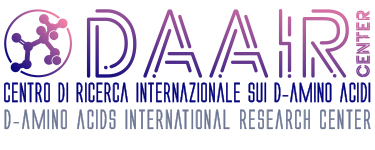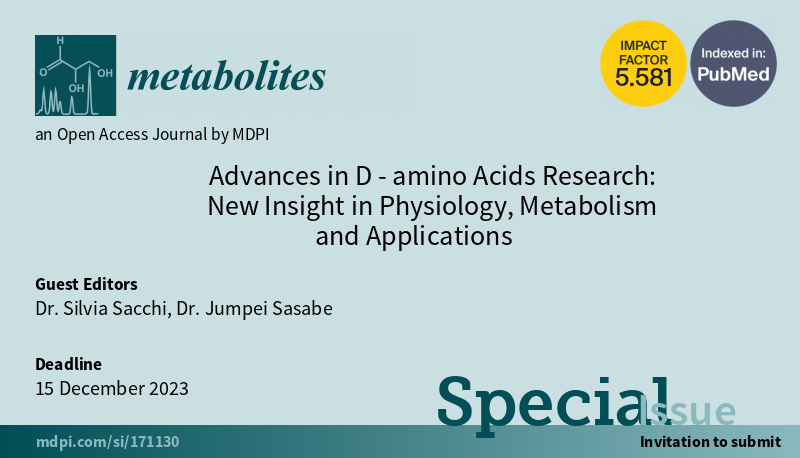
Conclusion of the research project “Dissecting serine metabolism in the brain”, a research by The Protein Factory 2.0 (Università degli Studi dell’Insubria) in collaboration with Università degli Studi di Milano, Università degli Studi di Roma “Tor Vergata”, Università degli Studi di Milano-Bicocca and Università degli Studi di Parma, funded by MIUR (PRIN 2017). Watch the videos presenting the research results:
A new Special Issue!

The Editor’s pick selection of the most intriguing papers is highlighted in yellow.
D-AAs AND PHYSIOLOGICAL ROLES:
Mammals sustain amino acid homochirality against chiral conversion by symbiotic microbes
Gonda Y, Matsuda A, Adachi K, Ishii C, Suzuki M, Osaki A, Mita M, Nishizaki N, Ohtomo Y, Shimizu T, Yasui M, Hamase K, Sasabe J
Proc Natl Acad Sci U S A. (2023) Apr 11;120(15):e2300817120. doi: 10.1073/pnas.2300817120
This work is aimed at demonstrating that mammals sustain systemic dominance of L-amino acids through both enzymatic degradation and excretion of D-amino acids (D-AAs). In blood, humans and mice maintain D-AAs at less than several percent compared to the corresponding L- ones, while D-AAs comprise 10-50% of the L- ones in urine and feces. Based on germ-free mice, it was reported that the vast majority of D-AAs, except D-serine, are of microbial origin. Based on mice lacking of D-amino acid oxidase, it was shown that catabolism is central to the elimination of diverse microbial D-AAs, whereas excretion into urine is of minor relevance. Notably, maternal catabolism during the prenatal period is crucial; a switch to juvenile catabolism along with the growth of symbiotic microbes after birth is apparent. This outstanding work deep insight the mechanisms modulating chiral balance of amino acids in mammals and the relevance of the host-microbial symbiosis interplay.
- D-Amino acids in biological systems
Du S, Wey M, Armstrong DW
Chirality (2023) Apr 19. doi: 10.1002/chir.23562. Online ahead of print.
This review reports on the occurrence and roles of D-amino acids, from bacteria to mammals. The known biosynthetic and regulatory pathways are presented, as well as the occurrence and role of D-amino acids in human disease.
- The chiral proteomic analysis applied to aging collagens by LC-MS: Amino acid racemization, post-translational modifications, and sequence degradations during the aging process
Morvan M, Mikšík I
Anal Chim Acta (2023) Jun 29;1262:341260. doi: 10.1016/j.aca.2023.341260
Collagen, the most abundant protein in the animal and human bodies, undergoes to age-related changes, such as amino acids racemization. In aging collagen, a natural amino acid racemization was observed, which increases with age. Indeed, post-translational modifications in aging collagens is proposed to explain the modification of the hydrophobicity of the protein. The authors reported the exact positions of D-amino acids and PTMs.
D-AAs AND PATHOLOGIES:
- Simultaneous measurement of amino acid enantiomers in the serum of late-life depression patients using convenient LC–MS/MS method with Nα-(5-fluoro-2,4-dinitrophenyl)-L-leucinamide derivatization
Liu M., He J., Ruan C., Pan W., Mao P., Sun Z., Wang G., Yang J.
Journal of Pharmaceutical and Biomedical Analysis (2023) 230, art. no. 115387. DOI: 10.1016/j.jpba.2023.115387
Here, an LC-MS/MS method for the simultaneous measurement of L- and D-amino acids (based on the chiral derivatization reagent Nα-(5-fluoro-2,4-dinitrophenyl)-L-leucinamide) was developed. The method allowed the separation of 21 amino acids (and of 18 chiral amino acids), with limits of detection of 0.03–4.0 nM, a linear range of 0.01–20 μM, and a suitable precision. The method was used for the quantification of serum chiral amino acids in late-life depression patients and controls: a significant difference was reported for glycine, L-threonine and D-methionine between late-life depression patients and controls. The authors proposed these amino acids re potential biomarkers of late-life depression.
D-AAs AND BACTERIA:
- Characterization of free L- and D-amino acids in size-segregated background aerosols over the Ross Sea, Antarctica
Feltracco M., Zangrando R., Barbaro E., Becagli S., Park K.-T., Vecchiato M., Caiazzo L., Traversi R., Severi M., Barbante C., Gambaro A.
Science of the Total Environment (2023) 879, art. no. 163070, DOI: 10.1016/j.scitotenv.2023.163070
In this work, aerosol samples were collected at Mario Zucchelli Station on the coast of the Ross Sea (Antarctica): the total mean concentration of free amino acids in PM10 was 4 ± 2 pmol m-3 and most of them were distributed in fine particles. The D-/L-alanine ratio in fine, coarse and PM10 fractions indicated the microlayer as the local source.
- Chirality of tyrosine controls biofilm formation via the regulation of bacterial adhesion
Li H., Wang Y., Zhao X., Yan Z., Song C., Wang S.
Biochemical Engineering Journal (2023) 192, art. no. 108844, DOI: 10.1016/j.bej.2023.108844
Biofilm is the main cause of membrane biofouling and microbial corrosion. Here, D-tyrosine was used to inhibit the adhesion of Escherichia coli. D-tyrosine inhibited the bacterial adhesion via lowering the adhesion force: extracellular proteins decreased by 45% leading to less hydrophobicity and autonomous aggregation of cells. D-tyrosine regulated tryptophan, curli, peptidoglycan, and adhesion-like protein synthesis, thus reducing cell aggregation and surface adhesion. This could represent a new strategy for biofilm reduction.
- Enhanced inhibition of HEDP on SRB-mediated corrosion with D-phenylalanine
Li H., Kang Z., Zhang K., Gong S., Zhao X., Yan Z., Wang S., Song C.
Environmental Research (2023) 227, art. no. 115754 DOI: 10.1016/j.envres.2023.115754
Here, D-Phenylalanine (D-Phe) and 1-hydroxyethane-1,1-diphosphonic acid (HEDP) were selected to evaluate their effect on the corrosion caused by Desulfovibrio vulgaris. Their combined use slowed down the corrosion process, retarded cathodic reaction, reduced the extracellular protein level and thus inhibited the biofilm formation. HEDP and D-Phe down-regulated the gene expression of peptidoglycan, flagellum, electron transfer, ferredoxin and quorum sensing (QS) molecules, thus leading to less peptidoglycan synthesis, weaker electron transfer and stronger QS factor inhibition.
D-AAs & BIOTECHNOLOGY:
- Prospects of Application of D-amino Acid Transaminase from
Aminobacterium colombiense for (R)-selective Amination of α‑Keto Acids
Shilova S.A., Rakitina T.V., Popov V.O., Bezsudnova E.Y.
Moscow University Chemistry Bulletin (2023) 78 (1), pp. 10 – 19, DOI: 10.3103/S0027131423010054
D-amino acid transaminase from Aminobacterium colombiense was applied for (R)-selective amination of 2-oxobutyrate, 2-oxovalerate and 2-oxo-4-phenylbutyrate to produce D-homoalanine, D-norvaline and D-homophenylalanine, by employing a one-pot three-enzyme system. The reaction was catalyzed by also adding (R)-2-hydroxyglutarate dehydrogenase and glucose dehydrogenase to shift the equilibrium of transamination toward the products. Under optimal conditions 435 mM D-homoalanine, 320 mM D-norvaline and 47.5 mM D-homophenylalanine were produced, with an enantiomeric excess higher than 99.5%.
- Systematic D-Amino Acid Substitutions to Control Peptide and Hydrogel Degradation in Cellular Microenvironments
Bomb K, Zhang Q, Ford EM, Fromen CA, Kloxin AM
ACS Macro Lett. (2023) May 17:725-732. doi: 10.1021/acsmacrolett.3c00144. Online ahead of print.
Since enzymatically degradable peptides are commonly used as linkers within hydrogels for biological applications, here the use of D-amino acids (D-AAs) in a peptide sequence commonly utilized in enzymatically degradable hydrogels (VPMS↓MRGG) was investigated. By increasing the number of D-AA substitutions, the resistance to proteolysis of both free peptide and peptide-linked hydrogels increased. Anyway, increased cytotoxicity in cell culture was also apparent.
- Synthesis and applications of mirror-image proteins
Harrison K, Mackay AS, Kambanis L, Maxwell JWC, Payne RJ
Nat Rev Chem. (2023) May 12. doi: 10.1038/s41570-023-00493-y. Online ahead of print.
This interesting review focuses on chemical protein synthesis of ‘mirror-image’ proteins (proteins fully made of D-amino acids instead of canonical L-enantiomers), which cannot be accessed using recombinant expression technologies. By reporting on recent works on synthetic mirror-image proteins, the review highlights their applications in protein crystallography, drug discovery and for the creation of “mirror-image life”.
- Ribozyme synthesis of both L- and D- amino acid oligos
Wang Y.
bioRxiv preprint doi: https://doi.org/10.1101/2023.04.28.538729; this version posted April 29, 2023
Incorporating non-natural amino acids into a protein is a challenging process that allows creating non-natural peptides by using ribozymes inspired by the peptidyl transfer center. These RNA scaffolds (about 100 nucleotides) bind to RNase T1 truncated tRNA-like chimeras and bring them into close proximity to facilitate peptide ligation. Mass spectrometry analysis confirmed the production of oligopeptides from four amino acids, including L-lysine, D-lysine, L-phenylalanine, and D-phenylalanine, thus opening new avenues in the synthesis of non-natural peptides.
- State-of-the-art strategies and research advances for the biosynthesis of D-amino acids
Wang F, Qi H, Li H, Ma X, Gao X, Li C, Lu F, Mao S, Qin HM
Crit Rev Biotechnol. (2023) May 9:1-19. doi: 10.1080/07388551.2023.2193861. Online ahead of print
D-alanine, D-leucine, and D-phenylalanine are used as sweeteners and fragrances. This review reports about biosynthesis pathways, multi-enzyme cascade and whole-cell catalysis for the production of selected D-amino acids. The paper also describes future challenges and perspectives of strategies-driven by bioinformatics technologies and smart computing technologies: new approaches will promote the production and use of D-amino acid in the food industry.
ENZYMES ACTIVE ON D-AAs:
- Kinetics of Thermoinactivation of D-Amino Acid Oxidase OPADAAO1 from the Ogataea parapolymorpha DL-1 Yeast
Koshkina M.K., Sergeyev E.P., Fedorov T.A., Shelomov M.D., Pometun A.A., Savin S.S., Tishkov V.I., Atroshenko D.L.
Moscow University Chemistry Bulletin (2023) 78 (2), pp. 69 – 75, DOI: 10.3103/S0027131423020049
Five genes form the yeast Ogataea parapolymorpha DL-1 potentially encoding D-amino acids oxidases were recently expressed in E. coli. Four (namely OpaDAAO1-OpaDAAO4) enzymes were purified and characterized: OpaDAAOl has the highest kcat with D-alanine. Here, its stability at elevated temperatures was investigated, as function of enzyme concentrations and exogenous FAD cofactor concentration.
- Semi-Rational Design of Diaminopimelate Dehydrogenase from Symbiobacterium thermophilum Improved Its Activity toward Hydroxypyruvate for D-serine Synthesis
Wang Z., Qu H., Li W., Xu Y., Nie Y.
Catalysts (2023) 13 (3), art. no. 576, DOI: 10.3390/catal13030576
Diaminopimelate dehydrogenase (DAPDH) can convert keto acids into the corresponding D-amino acids and was thus used for the efficient one-step synthesis of these latter compounds. In this work, the activity of the Symbiobacterium thermophilum (StDAPDH) H227V variant toward HPPA was studied by measuring D-serine production. Next, four residues (namely D92, D122, M152, and N253) located in the active pocket, were mutated by single-point saturation and iterative mutation: the D92E/D122W/M152S variant was obtained with an 8.6-fold increase in enzyme activity (specific activity of 0.19 U/mg). The increase in enzyme activity might be related to the change in substrate pocket size and the enhancement of the interactions between the substrate and key residues.
The D-amino acids International Research Center “DAAIR“ has been established in Gerenzano (Varese, Italy) in 2019 with the aim to support and perform scientific research projects and activities on the field of D-amino acids. The Center, located inside the Fondazione Istituto Insubrico Ricerca per la Vita, is aimed to represent a pole of excellence at international level for dissemination and research involving the D-amino acids (Director Silvia Sacchi).
The guiding principle is support the research projects aimed to investigate the involvement of D-amino acids in main physiological processes, from bacteria to humans. The ultimate goal is to actively participate to the elucidation of the mechanisms by which the D-amino acids perform specific functions, and to identify their presence and concentration in different organisms and compartments, also with regards to well-established functional states, with particular emphasis to pathological states. Understand the involvement of D-amino acids in important diseases as a way to set up novel therapeutic strategies.
Contacts: info@d-aminoacids.com;
director@d-aminoacids.com;
www.d-aminoacids.com
https://www.d-aminoacids.com/
mailing address: info@d-aminoacids.com
Commenti recenti